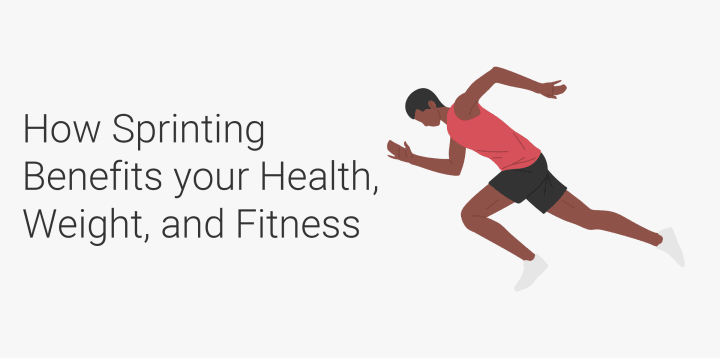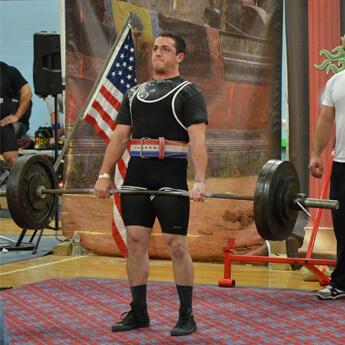
Sprinting is one of the most intense forms of working out that can give you the health benefits of exercising for an hour, in just a few minutes. Decades of studies have shown the benefits of exercise in improving one’s health, but one of the biggest challenges is squeezing in 30 minutes of exercise a day, which is the current exercise recommendation.
To determine the various benefits of sprinting, we spent 80+ hours researching and analyzing over 90 studies and broke the data down into the following sections:
- Heart health
- Physical fitness
- Weight loss
- Diabetics
- Brain and Mental health
- Bone and Joint health
Health Benefits of sprinting
Sprinting is great for heart health
Sprinting is an anaerobic exercise that uses quick bursts of speed at maximum intensity. It gets your heart pumping but still has ample recovery periods per session. It allows the heart muscles to get stronger and function well.
With even low-intensity activity such as walking benefits your heart health, this high-intensity exercise is known to provide significant cardiovascular health benefits:
- 7.8% decrease in resting heart rate
- Lower diastolic blood pressure by 3.8%
- 7% decrease in mean arterial pressure
- Reduction of 6.5 to 20.1% in total cholesterol
- Decrease in triglyceride LDL levels by 27.8%
- Lower triglyceride level by 29.4 to 37%
- 6.7 to 7.1% increase in HDL
Sprinting builds muscle, strength, power, speed, and endurance
Because of the maximum effort used during sprint exercise, it provides all the traditional benefits of cardio and more.
Studies have shown sprinting helps with muscle growth and can make you stronger and run further, for longer, with greater speed and power.
Sprinting for 6 to 12 weeks can:
- Increase lean muscle mass by 1%
- Improve VO(2max) by 11.5 to 23.4%
- Adherence rates for sprinting is 74.2%, higher than other forms of exercise because it is time-efficient
Meanwhile, trained athletes who did SIT for just 2 weeks improved:
- Maximal aerobic speed by 2.3%
- Peak power by 2.4%
- Mean power by 2.8%
- 3,000-meter time trial by 6.0%
- Endurance, lasting 42% longer than before SIT
This makes sprinting one of the only forms of cardio, second to the benefits of rowing, which can significantly improve physical fitness, strength, and muscle.
Benefits of sprints for fat and weight loss
Sprinting is one of the most effective forms of exercise for weight loss, even outweighing the benefits of HIIT.
In fact, in our previous study, “Sprint Interval Training: Burn 40% More Fat Than HIIT in 60% Less Time,” we discovered that sprinting could burn 40% more fats compared to HIIT. It can also suppress appetite until after 90 minutes post-workout.
Other benefits of sprinting include:
- Reduction of fat mass by 12.4%
- Shrinkage of skinfolds in the tricep, subscapular, suprailiac, abdominal, and thigh, totaling 22.2%
- Lowering total body mass by 2.7%
- Decreasing whole-body fat mass by 7.8%
- Reducing abdominal visceral fat area (AVFA) and abdominal subcutaneous fat area (ASFA) by 7.5%
- Increase perilipin (PLIN2 90%, PLIN5 type I 47%, and PLIN3 type I 63% and type II fibers 70%), which, in turn, lowers diacylglycerol and ceramides that adds to the risk for obesity
Sprinting and diabetes: improving blood sugar levels, insulin sensitivity, and insulin resistance
Sprinting is an anaerobic form of exercise which means the body’s demand for oxygen is greater than the supply. This forces the body to burn more glucose and calories to supply the energy needed by your body.
Because of this, sprint exercise has been found to be an ideal workout for diabetics or those who need to control their blood sugar level. All the while improving insulin sensitivity, insulin resistance, and potentially helping reduce their insulin or medication dosages similar to the benefits of cycling.
According to research:
- SIT can increase insulin sensitivity by 53%
- Intense sprint workouts can elevate blood glucose by 1.2 mmol/liter right after but return to pre-exercise levels post-recovery
- SIT for 8 weeks resulted in increased insulin sensitivity as evidenced by a lower blood glucose level 120 minutes after an oral glucose tolerance test
Benefits of sprinting for your brain, mental, and emotional health
Like cardio exercises, sprinting also has positive effects on a person's brain activities and mental health. According to a study on young adults, the effects of aerobic and anaerobic (sprinting) exercises on a person's mental well-being are almost the same, and in some categories, even higher.
Sprinting promotes the release of endorphins in the body which:
- Decrease depression and anxiety by 24.3%
- Lower stress by 26.6%
- Increase the feeling of happiness by 20.1%
Meanwhile, a session of sprinting provides brain health benefits such as:
- Increase reaction time by 3.3%
- Accuracy is enhanced by 0.5% immediately after SIT
- A 15% increase in the Brain-derived neurotrophic factor (BDNF), which is responsible for cognition, attention, and memory, immediately after 20 minutes of sprinting
- 1-2% increase in hippocampal volume which is associated with improved spatial awareness
Sprinting for joint and bone health
According to the National Osteoporosis Foundation, 30 minutes of weight-bearing exercises like sprinting several times per week, can help enhance bone density and reduce the risk of developing osteoporosis.
Some of the bone benefits of sprinting include:
- A 2.4% higher bone mineral density compared to long-distance runners
- A bone mass density 23% higher than those who do not do high-impact workouts
- 10-14% more BMD in the hips than those who do endurance training and non-athletes
As for the joints, a Danish study suggests that because you take many fast steps while sprinting, you spend less time covering the same distance compared to running, thereby reducing the cumulative load on the knee joint. Similarly to how jumping rope benefits your bones through quick, but strong, repetitive jumps.
Based on several studies:
- Sedentary individuals are 10.2% more likely to develop hip and knee arthritis than sprinters
- Non-sprinters are 2.4% more likely to develop severe osteoarthritis
- Runners and sprinters are 29% less likely to have knee pain than those who are sedentary
FAQs
Is it healthy to sprint every day?
No, because your body needs time to recover. Sprinting requires maximum effort, which if done daily, will lead to over exhaustion and excessive damage to the muscles.
Instead you need to give your body and muscles time to heal and recover between sprint workouts.
Can sprinting give you abs?
Yes, because when you run or sprint, you engage your core muscles. If you’re not, you better start doing so. Engaging your core not only helps with proper running posture, but it also burns belly fat and tones them.
Does sprinting build muscles?
Yes, sprinting does build muscles and not only in the legs. Unlike running where people tend to lose muscle if they overdo it, sprinting works your muscle. Because you run at top speed from the get-go, your thigh and leg muscles are pushed into overdrive.
The more you sprint, these muscles get stronger and bigger. These muscles include the glutes, hamstrings, quadriceps, and calves.
Sprinting also tones your upper body muscles. Because you run at a very fast pace, you need to be able to keep your balance. Your swinging arms act as levers that propel you forward.
Meanwhile, your chest and back muscles are taut and working double time when you sprint to prevent your upper limbs from over swinging and result in loss of balance.
What shoes to wear for sprinting?
If you’re serious about sprint workouts, it would be best to invest in a good pair of sprint shoes. Sprint shoes are quite different from running shoes as they lack the typical bouncy cushioning.
Sprint trainers usually have spikes or lugs under the forefoot section to help them grip the surface and prevent slipping.
The forefoot is also visibility slanted upwards which helps position the foot to land on the ball and not the heel. This position helps the foot to readily push forward when it lands. As for the heel part, it is quite thin and flat.
Can I use running shoes for sprinting?
Not all running shoes are ideal for sprinting. Sprinters tend to move away from running shoes with very thick cushioning as the bounce can attenuate energy transfer and make you run slower or lose balance.
If you find spiked sprint shoes to be too limiting in terms of use, another option to consider is minimalist running shoes. Minimalist running shoes offered by Vibram, Merrell, and others have very thing sole units that allow wearers to ‘listen’ to how their feet move with every step, so they can adjust how they land or push off so they can run more efficiently.
Does sprinting make you run faster?
Sprinting can help you run faster. Because sprinting engages and tones the major muscles of the legs and thighs, they become stronger compared to the legs of distance runners. Also, sprinting enhances a person’s endurance which means they can run longer but not get tired too fast.
Is sprinting good for seniors?
Sprinting is known to be incredibly beneficial for seniors and older adults. Studies have shown that short-duration sprints are better for older adults. SIT can lower blood pressure, improve lipid profile, and enhance mobility - which are all issues that the aging population deals with.
Conclusion
Sprint interval training is one of the most effective forms of intense exercise to achieve health benefits in a short period. Unlike moderate-intensity continuous training that you need to do 5 times a week for an hour or more to reap the benefits, you can do SIT less than 10 minutes a day, for as little as 3 days per week, and still get a rockin’ healthy body.
Sprint interval training can be done by anyone at any fitness level and suits people who do not have hours to spend time in a gym to get fit. Also, sprint training is a cheap form of workout because all you need to invest on is a good pair of sprinting shoes.
About RunRepeat
RunRepeat has the biggest database of shoe reviews. We buy all the shoes on our own and we test them in-house: outside on the track and inside, in our lab. In the lab, we cut the shoes in half which allows us to compare the shoe on the additional 20+ parameters with other shoes. This unbiased approach ensures you get the most objective overview of the shoe's performance out there.
One of the highly-rated sprinted shoes on RunRepeat is theAdidas Sprintstar. Another sprint shoe people raved about is the Nike Air Zoom MaxFly. Though pricier than other sprint shoes, its lightweight construction, superb grip, and overall comfort have been immensely praised. The notched laces stay tied for the reliable upper lockdown.
Use of content
- If you wish to learn more about the benefits of sprinting, you can send your questions to Nick Rizzo at nick@runrepeat.com. He’s also available for interviews.
- Feel free to use data found in this article on any online publication. We only request that you link back to this original source.
References
- https://www.facetsjournal.com/doi/10.1139/facets-2016-0004
- https://pubmed.ncbi.nlm.nih.gov/28391489/
- https://link.springer.com/article/10.1007/s11332-018-0498-2#Tab1
- https://pubmed.ncbi.nlm.nih.gov/20473222/
- https://pubmed.ncbi.nlm.nih.gov/30568598/
- https://pubmed.ncbi.nlm.nih.gov/28391489/
- https://journals.lww.com/nsca-jscr/Fulltext/2018/03000/Six_Sessions_of_Sprint_Interval_Training_Improves.5.aspx
- https://pubmed.ncbi.nlm.nih.gov/20473222/
- https://pubmed.ncbi.nlm.nih.gov/30568598/
- https://pubmed.ncbi.nlm.nih.gov/30123136/
- https://pubmed.ncbi.nlm.nih.gov/28736444/
- https://journals.physiology.org/doi/full/10.1152/japplphysiol.00218.2017
- https://www.healthline.com/health/fitness-exercise/aerobic-vs-anaerobic#Why-anaerobic-exercise-is-better-for-fat-loss
- https://pubmed.ncbi.nlm.nih.gov/28391489/
- https://academic.oup.com/jcem/article/97/11/4193/2836634
- https://pubmed.ncbi.nlm.nih.gov/22540332/
- https://sites.kowsarpub.com/zjrms/articles/14349.html#:~:text=Results%3A%20The%20results%20showed%20that,apparent%20in%20the%20anaerobic%20group.
- https://www.ncbi.nlm.nih.gov/pmc/articles/PMC4929070/
- https://pubmed.ncbi.nlm.nih.gov/27450438/
- https://www.ncbi.nlm.nih.gov/pmc/articles/PMC6148340/#:~:text=A%20general%20consensus%20has%20emerged,116%2C%20148%2C%20149).
- https://www.health.harvard.edu/staying-healthy/slowing-bone-loss-with-weight-bearing-exercise#:~:text=Numerous%20studies%20have%20shown%20that,bone%2Dforming%20cells%20into%20action.
- https://www.nof.org/patients/treatment/exercisesafe-movement/how-much-exercise-do-you-need/
- https://www.jospt.org/doi/full/10.2519/jospt.2015.5469
- https://pubmed.ncbi.nlm.nih.gov/23242430/
- https://www.sciencedirect.com/science/article/pii/S2214031X15000364
- https://www.ncbi.nlm.nih.gov/pmc/articles/PMC6028830/
- https://pubmed.ncbi.nlm.nih.gov/28504066/
- https://pubmed.ncbi.nlm.nih.gov/18550323/
- https://pubmed.ncbi.nlm.nih.gov/27333572/
- https://betterhumans.pub/this-is-how-to-grow-strong-by-sprinting-fed7595bd8f1
- https://www.popsugar.com/fitness/Does-Sprinting-Build-Muscle-45545475
- https://www.livestrong.com/article/510154-what-kind-of-physique-would-you-get-from-only-running-sprints/
- https://link.springer.com/article/10.1007/s11332-018-0498-2
